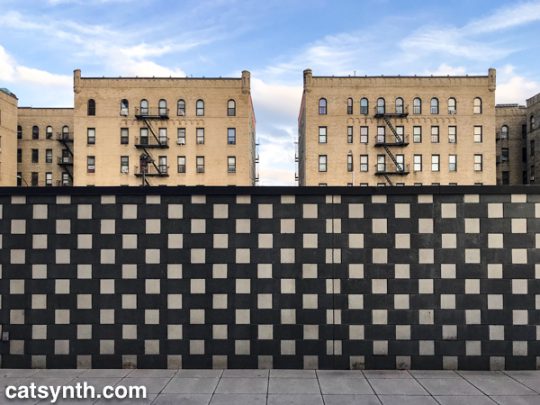
“Twin” apartment buildings in the Bronx, east of the Grand Concourse, as seen from the terrace of the Bronx Museum of Art.

We at CatSynth have been extraordinarily busy since the start of summer with work, music, and other obligations. As a result, our explorations of visual art have suffered a bit. But we start correcting that today with a report from the blockbuster René Magritte: The Fifth Season exhibition at SFMOMA. I’m glad I was able to get in to see it before it closes in two weeks!
The exhibition focuses on his later works, from World War II through the late 1960s. It is billed as “If you think you know Magritte (1898–1967), think again.” Yet, this period includes many of his most iconic works – other than perhaps his most famous La Trahison des images (aka “this is not a pipe”), including many of my favorites from the broader Magritte retrospective I had seen at SFMOMA in the early 2000s.
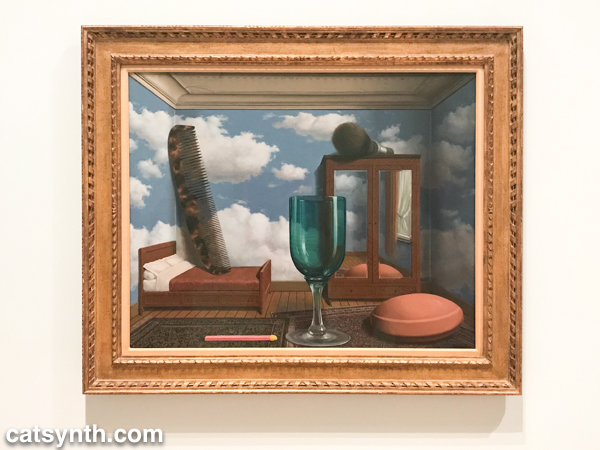
The work depicted above, Les valeurs personnelles, is perhaps my favorite of all. I find myself drawn to it not just because of the stark juxtaposition of larger-than-human-sized objects in a smaller-than-human-sized space, but for the various textures that defy painting. The objects themselves have the hyperrealistic sheen of graphics from the 1990s (we were all proud of our ability to render glass) with the more pedestrian room space and strangely realistic sky on the wall. These are the characteristics of many of Magritte’s pieces during his Hypertrophy period in the 1950s. It’s taken to an extreme in a piece that features one of his iconic green apples swelling to gargantuan proportions and pushing against the walls of a modest room.
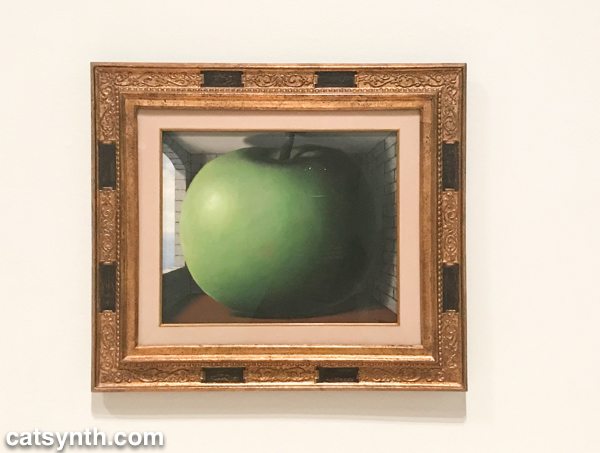
And of course, there were many bowler-hatted gentlemen, some with green apples, some without.
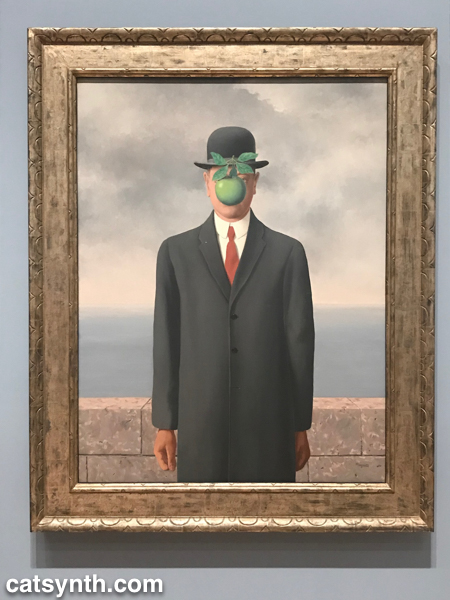
The image of the bowler hat and the bowler-hatted man has appeared throughout Magritte’s career, but it was more closely associated with the artist himself in his later works, a form of
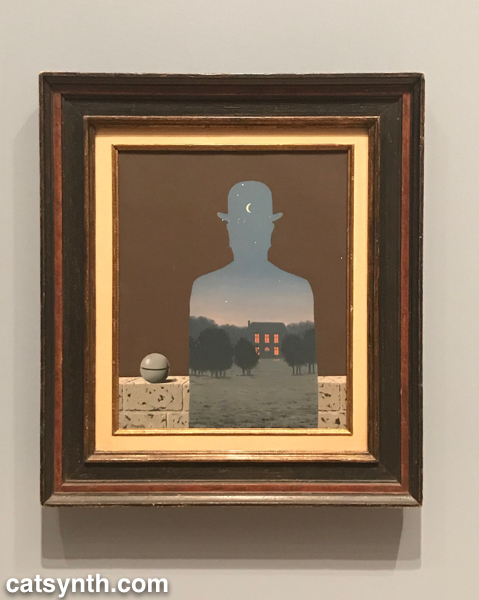
In addition to the green apple, we see many objects and concepts that appear in other works from this period applied to the bowler-hatted man, such as the small round stone, birds, and negative spaces.
In both sets of works, we see the discrete juxtaposition of elements that may or may not fit with real-life experience. I see this is as “quintessentially Magritte” and consistent throughout most of his career. In that sense, I disagree a bit with the thesis of the exhibition that this later period was a break with surrealism, but rather a reimagining of it with different subjects and techniques and without the heaviness of the
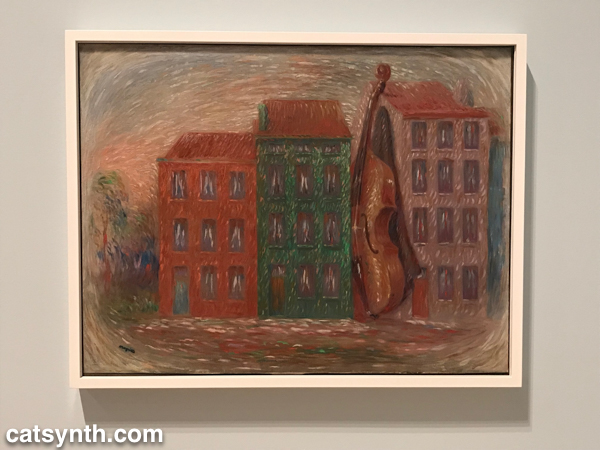
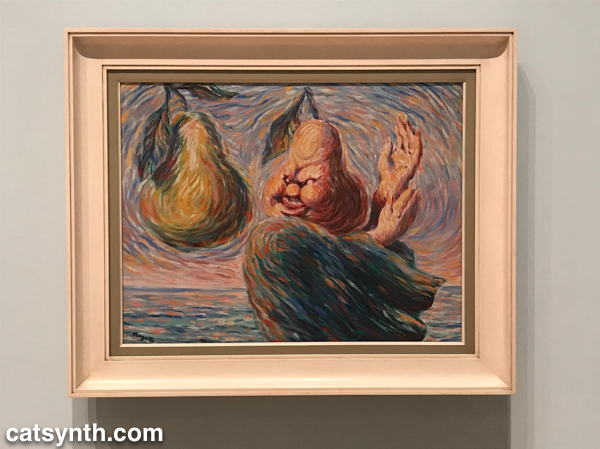
I would never have guessed these grotesque parodies of van-Gogh-style impressionism were his work if they were not presented and explained. At the same time, it is not surprising that the experience of the war (Magritte remained in his native Belgium during the Nazi occupation). It feels like his weakest and least memorable work, but one theory suggests that his retrograde style during this period helped avoid Nazi attention and persecution. We are certainly glad he returned to form in his later years.
One of late series, collectively called The Dominion of Light, brings together a nighttime city streetscape with a daytime sky.
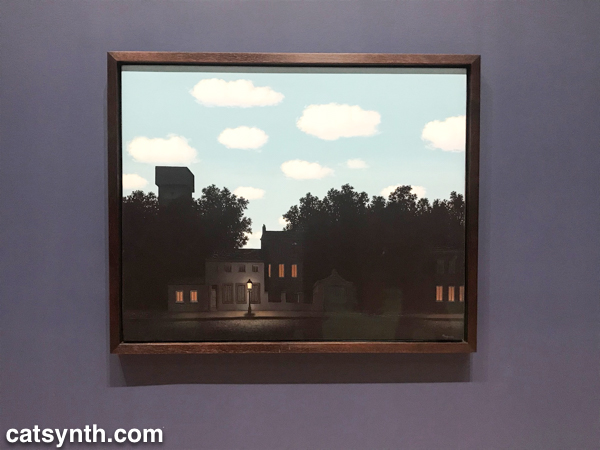
It takes a moment of adjustment to realize the confounding of night and day in the image, as our eyes are so used to assumptions about the passing of time and light. The series is at once playful, but also a bit melancholy, pointing to the later years of a life and life’s work. Fortunately, there was one more chapter to come that was both more curious and more
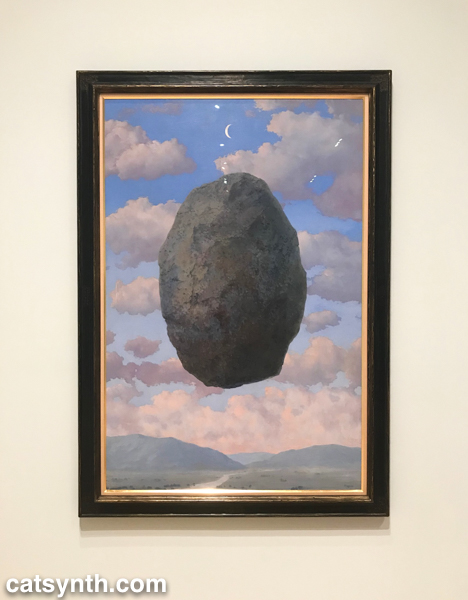
This bizarre series of boulders floating in space or sitting isolated on an apartment terrace is a return to form, but also an exploration of time and gravity and even more fundamental assumptions that we make in everyday life. Their lightness and starkness also make an interesting statement at the end of a career that spanned several decades and saw the massive changes of the 20th century. We should note that the bowler-hat portraits featured in this article were done during the same late period, and are stronger both as works in themselves and as a career-spanning statement.
The exhibit was overall a delight to experience. It was hung in a minimalist but also warm style without too much crowding or overwhelm, and it weaved a narrative even as I took in the works as individuals. It also marked a return a place of solace, the museum, after a long period of intensity and focus on other practices. I won’t stay away as long again.
If you are in San Francisco over the next couple of weeks, I strongly recommend checking this exhibition out before it closes on October 28. For more information, please visit https://www.sfmoma.org/exhibition/rene-magritte/.
I found myself back again in Napa Valley wine country a couple of weeks ago. Specifically I was in St. Helena to meet Elsie the Library Cat. I am not a morning individual, but Elsie apparently is, so at the early hour of 7AM, I headed up from San Francisco, crossing two bridges before exiting the I-80 onto Highway 29.



 I have written about traveling through the Napa Valley on Highway 29 before, specifically in a post from 2007. Once again Highway 29, multiplexed with Highway 12, was a parking lot south of the city of Napa, so I was once again able to snap a photo at almost the same exact location. It was quite theraputic to do so, chasing away some of the demons of 2007, which themselves chased out the demons of 2000. The road has been upgraded into a better expressway, and Highway 221 (just a short connector to downtown) is now signed.
I have written about traveling through the Napa Valley on Highway 29 before, specifically in a post from 2007. Once again Highway 29, multiplexed with Highway 12, was a parking lot south of the city of Napa, so I was once again able to snap a photo at almost the same exact location. It was quite theraputic to do so, chasing away some of the demons of 2007, which themselves chased out the demons of 2000. The road has been upgraded into a better expressway, and Highway 221 (just a short connector to downtown) is now signed.

The traffic thinned out north of Napa as the road narrowed north of Yountville. Here the landscape is dotted with modest vinyards and over-the-top mansions and tasting rooms. Finally, I arrived in St. Helena, my favorite town in the region. I pulled into the library parking lot around 9AM, just in time for my visit with Elsie.

Elsie is a very sweet cat, and quite playful at times despite her advancing age. With her black coat, she reminded me a bit of Luna, though Elsie has mismatched-colored eyes compared to Luna’s emerald green. She and the staff of the St. Helena Public Library were great hosts and extremely welcoming of me and my video project. If you haven’t already seen our CatSynth TV feature on Elsie, you can watch it here.
It was still relatively early when I finished at the library, so I headed to the main street in town for brunch – a protein-heavy heuvos rancheros and some additional coffee seemed like a good idea after the morning video shoot and before heading out for wine tasting.
My main winery destination was Flora Springs, also in St. Helena. In 2014, I had come here for both wine tasting and a photo shoot – you can see one of the photos in this old Wordless Wednesday post. I had selected it because of the modernist architecture and interior design, but I enjoyed the spicy bold reds as well. Plus they have a patio that is lovely on a warm afternoon.
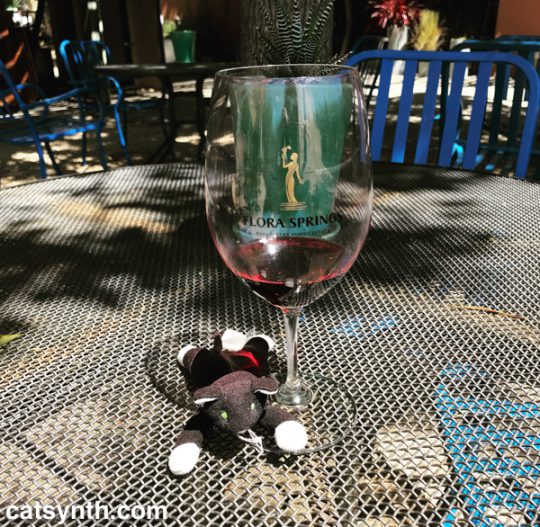
The same qualities that attracted me to this winery four years ago were in play again – the modern style and bold red wines. I particularly liked the Trilogy red blend and the Holy Smoke single-vinyard cabernet from Oakville. This visit was also featured on CatSynth TV.
 Having enjoyed a full glass of both the Trilogy and Holy Smoke along with tastings of the standards, I decided I shouldn’t do anymore tasting for a while. But I still wanted to some more exploring. So instead of heading straight back south, I turned east onto Highway 128 in Rutherford towards Lake Berryessa, with the goal of finally completing the route. (Yes, I am weird that way.)
Having enjoyed a full glass of both the Trilogy and Holy Smoke along with tastings of the standards, I decided I shouldn’t do anymore tasting for a while. But I still wanted to some more exploring. So instead of heading straight back south, I turned east onto Highway 128 in Rutherford towards Lake Berryessa, with the goal of finally completing the route. (Yes, I am weird that way.)

The narrow but well maintained highway took us out of the valley and into the hills to the east, winding our way through several canyons. The central towns of the Napa Valley were largely spared from last fall’s devasting fires, but here along Highway 128 one could still see some of the scars from the Atlas Fire. The green wooded hillsides were periodically streaked with bands of ashen gray and bare trees. But even within those bands, one could see bits of green. Some of these were trees that were spared during the fire, which jumps from one tree to another, as well as new growth replacing the burns. It’s amazing to see how quickly nature bounces back, especially compared to human development. It will take a bit longer to replace the homes, wineries and other businesses, and the mental and emotional scars may never heal.
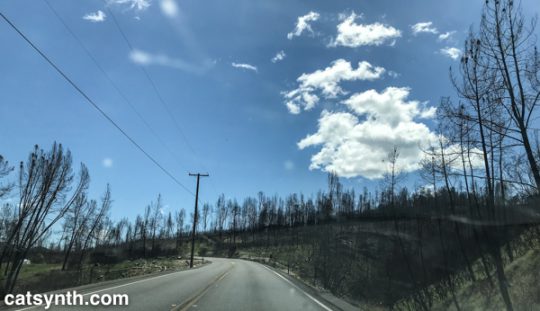
Eventually, the highway aligns to the southern shore of Lake Berryessa, an artificial lake created by damming the Putah Creek. It’s quite large and major center for water recreation. I was just there for the visual aspect – I was particularly curious to see the “Glory Hole.”
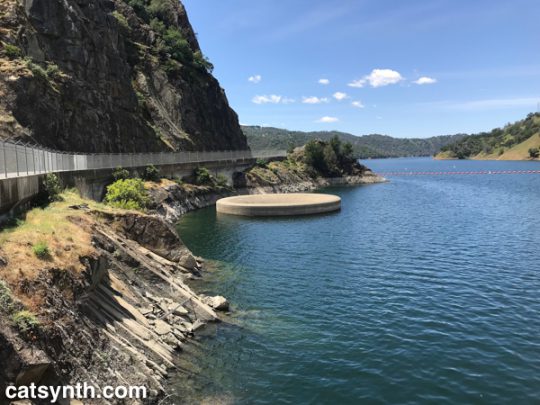
The Glory Hole, which as also featured in a recent Wordless Wednesday post, is an internal spillway for the reservoir. When the lake gets too full, the water drains out through it like a bathtub. This happened in 2017, and must have been amazing to see.
We followed the highway down from hills into the Sacramento Valley, where it ends in the town of Winters. I had stopped here on the way to Portland a few weeks earlier, so had already shot some video. But that one is still a work in progress…
See more of California’s Napa Valley Wine Country and many other fascinating places in our Highway☆ app, available on the Apple App Store and Google Play Store.

Once again, it is time for our end-of-year collage and review. So many images to choose from in such a busy 2017 that took us in so many directions at once, both outward and inward.
At the end of 2016, I was still reeling from the loss of Luna and the election. But I did welcome Sam Sam into my life and also promised myself that I would prosper and thrive in the new terrifying Trump era. And we did, focusing on moving forward with the things from 2016 that did go well. Lots of new music as a solo performer, with my new band CDP, and with Vacuum Tree Head. There are now three CatSynth-branded apps for both iOS and Android, and a fourth on the way. We launched CatSynth TV, with 22 videos under our belt since October. And Sam Sam has blossomed into a sassy and thoroughly spoiled cat whom we love dearly.
If there is a word of caution on the personal and professional fronts, it is perhaps that 2017 was too much. After a strong first half of the year through July, I scaled back on live performance to focus on other priorities. I regret that, but it was also the reality of the many things going on. I wish the apps, blog, and video channels were progressing faster, but it’s as fast as we can go with our myriad other responsibilities. The last couple months, while still rich with experience, have been an exercise in paring back and trying to focus on the highest priorities; and also focus on health, self-care, and well being. These are all very challenging, but I’m grateful to have the help of loved ones.
We cannot ignore the fact that our rebound in 2017 after two difficult years took place amidst a dark pall over the country and world. Many friends have suffered amidst the monumental forces of hurricanes, flooding, fires, and human foolishness. The latter is most visible in the face of the current regime that continues to embarrass and threaten us. These are things we have to be vigilant about as we move in 2018. I do feel personally in the cross-hairs on multiple fronts, so I hope we can continue to survive and prosper as well as we did in 2017, and maybe at the end of 2018 we will look back and saw how the world became at least a slightly better place.
It is also interesting to look back to our end-of-year post from 2007, ten years ago. It was a dark, cold time amidst major life changes – I couldn’t have imagined then what life would be like now. Will we feel the same way in 2027? And will there still be a CatSynth then? Only time will tell…
I make a point of dropping in the Bronx Museum of the Arts when I’m back in New York. This most recent visit did not disappoint, with three strong exhibitions of arts with connections to the borough and New York City at large.

Gordon Matta-Clark: Anarchitect turns familiar notions of architecture upside-down with many projects featuring cuts, holes, and other modifications to derelict and abandoned buildings in New York and beyond. The Bronx of the 1970s was one of his main canvases and the point of departure for his practice. His series featuring the iconic graffiti of the borough’s subway trains and facades leads the exploration, with Matta-Clark observing the built environment as it is.

The next level of his work modifies the built environment by adding his own elements, or rather removing parts of existing architecture. In his Bronx Floor series, Matta-Clark removes a section of the floor of an abandoned building on Boston Road. This serves as a setting for installations and photography.

[Gordon Matta-Clark. Bronx Floor]
Like Matta-Clark, I find these spaces of the Bronx of the 1970s quite inspiring on an aesthetic level. My enjoyment of this often overlooked aesthetic is a bit tempered by the notion that these buildings ended up this way through a variety of bad circumstances: neglect (sometimes deliberate), poor city planning, rising inequality, etc.
From the foment of the South Bronx, Matta-Clark took his concept to Manhattan. In his 1975 project Day’s End, he cut large holes into the abandoned Pier 52 along the Hudson River (I remember the derelict piers that used to line the lower West Side all to well from the 1970s and 1980s).

[Gordon Matta-Clark. Day’s End (Pier 52 in Manhattan)]
This served both as a sculpture and installation in its own right, but also as a performance an exhibition space. Interestingly, the authorities did not notice the initial work cutting out a piece of the building, but they did find out about the performances and happenings, and were none too pleased by this. Eventually, the city dropped charges while he was working on a project in Paris.

[Gordon Matta-Clark. Conical Intersection (Paris)]
Conical Intersect cuts out a section of a partially demolished mansion in the Les Halles district, adjacent to the still-under-construction Centre Georges Pompidou. This was the setting for film and still photography projects, as well as performances and happenings (including “including roasting 750 pounds of beef for passersby on the Pompidou plaza” [
[Susannah Ray. Hutchison River and Co-Op City, 2015.]
Seeing Ray and Matta-Clarks photographs in the same visit shows the evolution of the Bronx, and in particular how the natural spaces have improved since their nadirs in the early 1980s. The lower Bronx River was once a disaster but is returning to new natural-urban balance in recent years.

[Susannah Ray. Canoes, The Bronx River, 2013]
You can read more about the revitalization of the lower Bronx River in this 2016 article. Again, we find beauty in these spaces and admire the work that Ray and others are doing to share it.
The final exhibition takes a decidedly inward turn compared to the explorations of Ray and Matta-Clark. In Elegies, artist Angel Otero explores the long history of painting. His large “deconstructed” paintings bring together traditional practice, abstraction, and collage.

[Angel Otero. The Day We Became People, 2017]
The exhibition is organized in relation to Robert Motherwell’s Elegy to the Spanish Republic series and includes stark black-and-white pieces from Motherwell, sometimes with statements on art and painting.

[Robert Motherwell]
Otero’s work stands apart from Motherwell’s in its vibrant colors and relation to space, as well as its unique use of material. Although titled Elegies, the paintings are not really elegies at all – or at least not in the typical sense. There is an optimism in his work.
The paintings were all created specifically for this Bronx Museum exhibition.
Our visit to the Bronx Museum was also the subject of a recent CatSynth TV episode, which also took us a little further south to visit our friends at the Bronx Brewery in Port Morris.